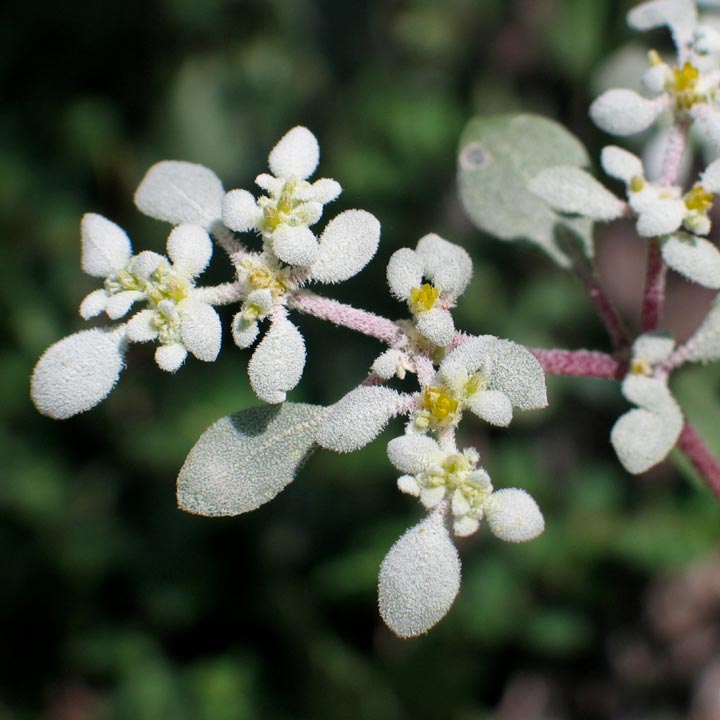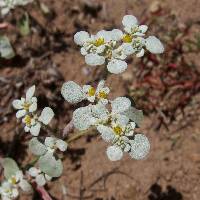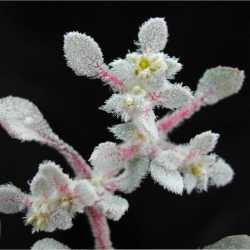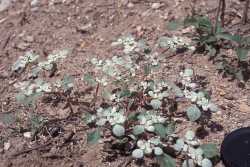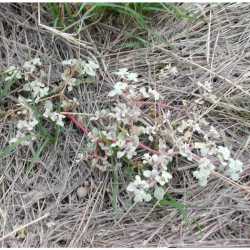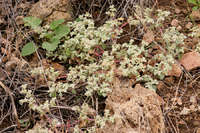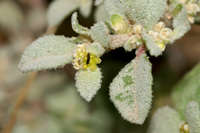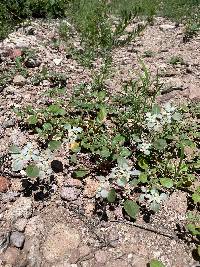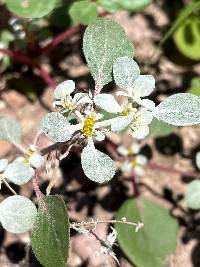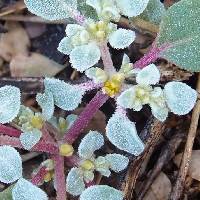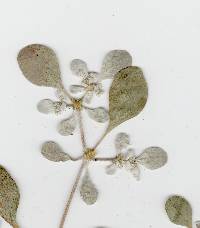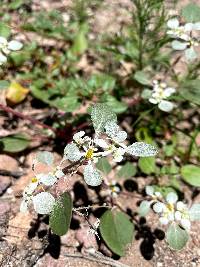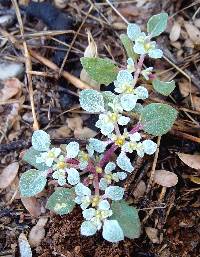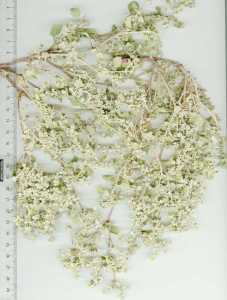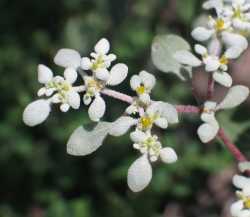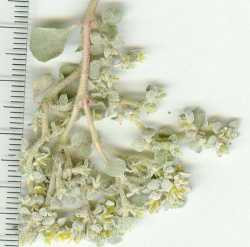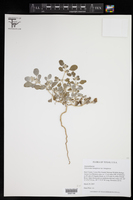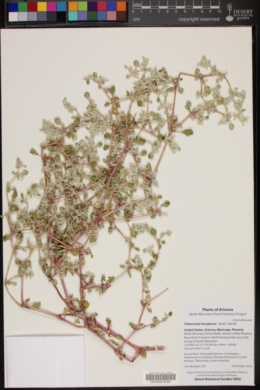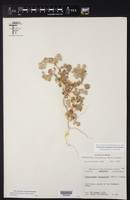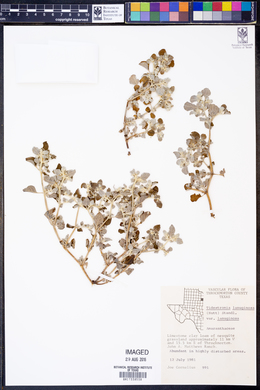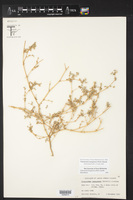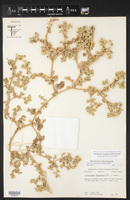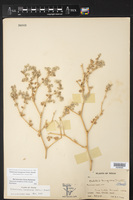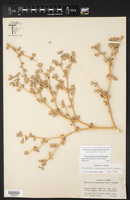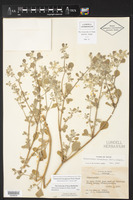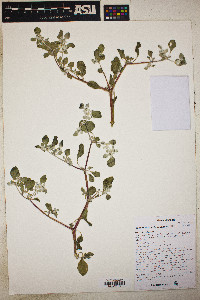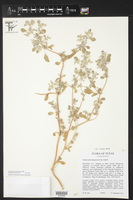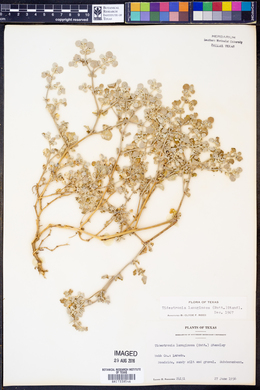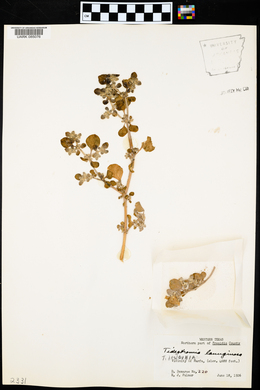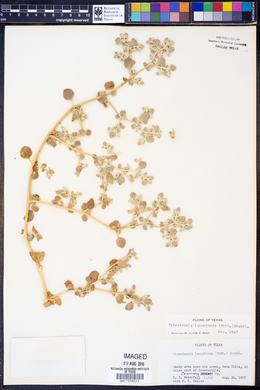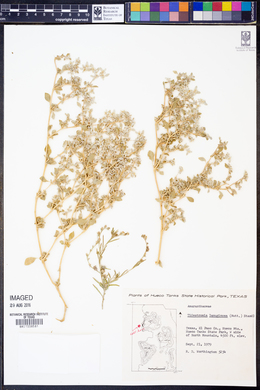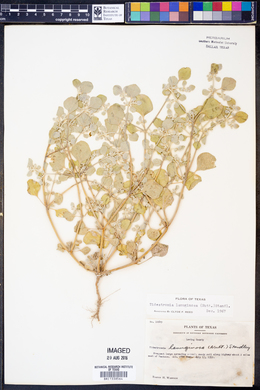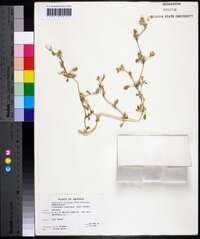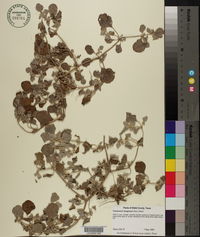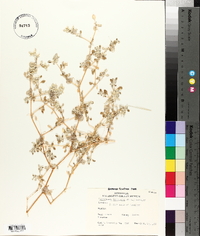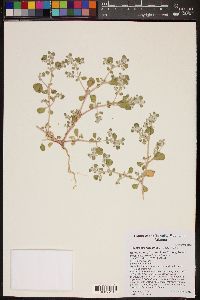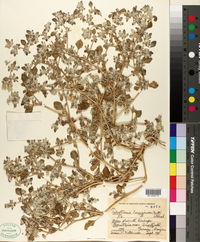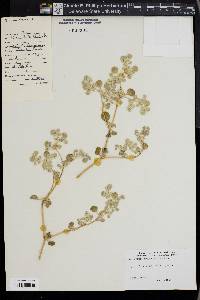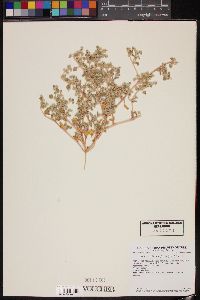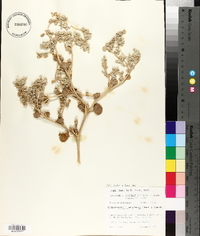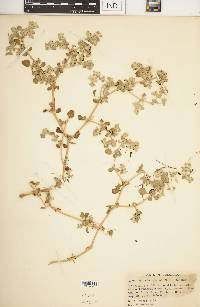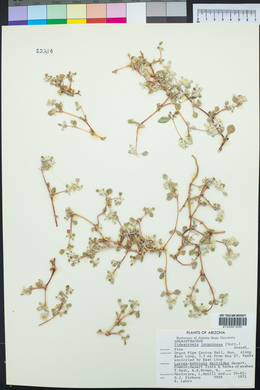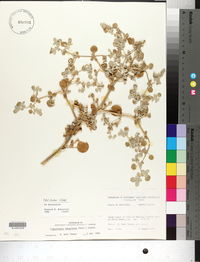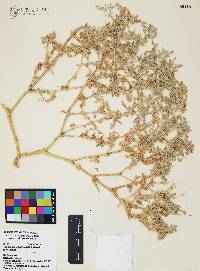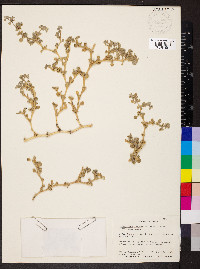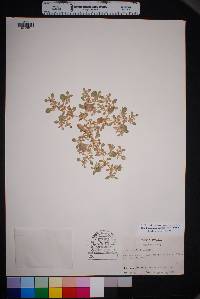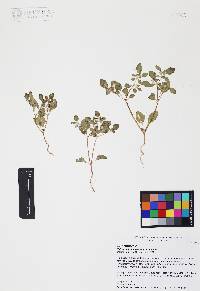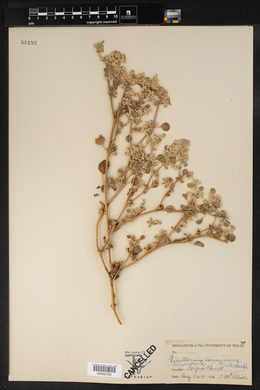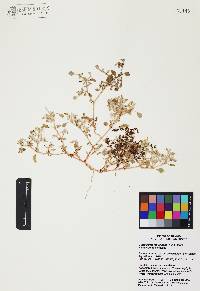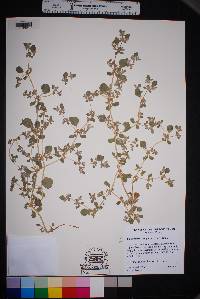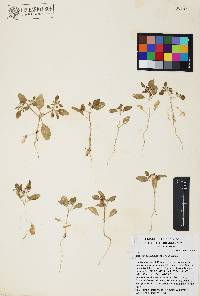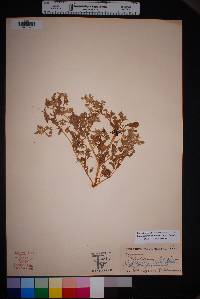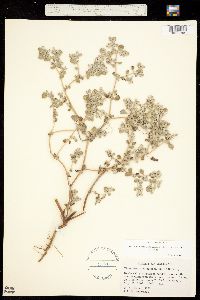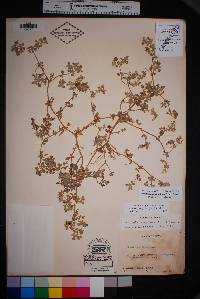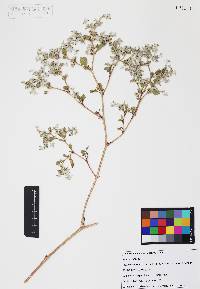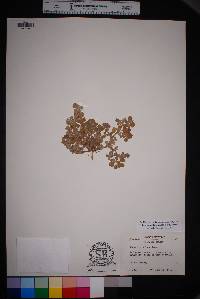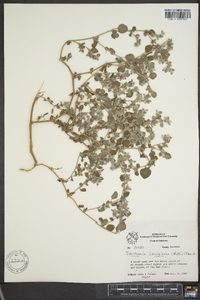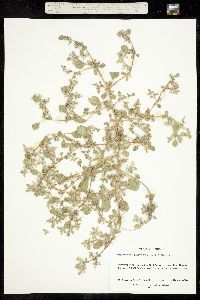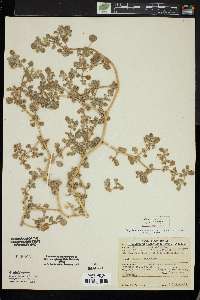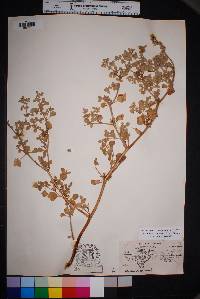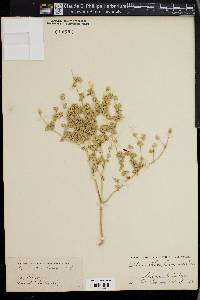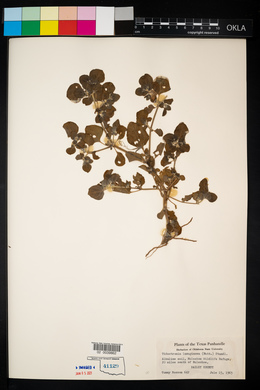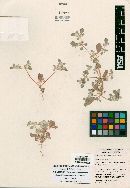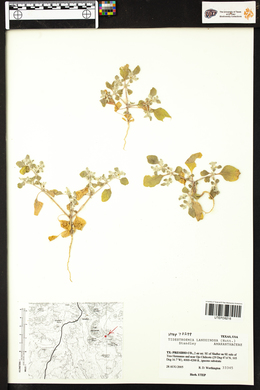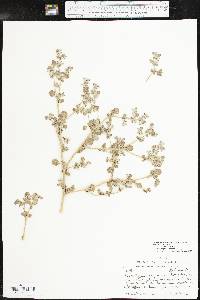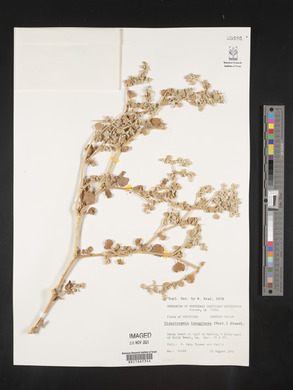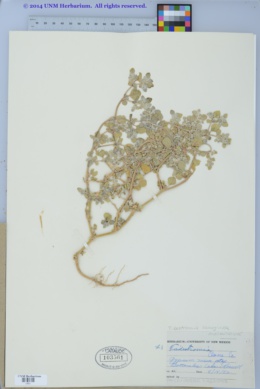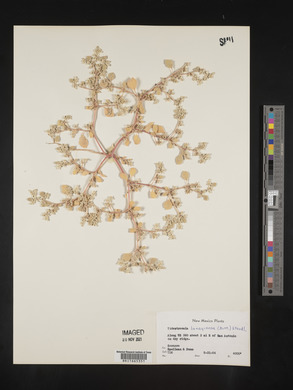Tidestromia lanuginosa
|
|
|
|
Family: Amaranthaceae
Woolly Honeysweet, more...woolly tidestromia, honeysweet, honeymat, wooly tidestromia (es: hierba lanuda, hierba ceniza, espanta vaqueras)
[Achyranthes lanuginosa T.Nuttall, moreAlternanthera lanuginosa (Nutt.) Moquin-Tandon, Cladothrix lanuginosa Nutt.] |
Herbs, annual, yellowish green to gray-green or rarely reddish, to 50 cm, canescent, lanuginose, or glabrous; trichomes completely candelabriform. Stems ascending, decumbent, or prostrate, herbaceous, buds absent on stem bases. Leaves: petiole to 2.5 cm; blade gray-green, widely obovate, ovate-trullate, circular, or lanceolate, 0.8-3.2 × 0.9-3 cm, chartaceous to fleshy, base attenuate or oblique. Inflorescences 1-3-flowered; involucral leaf petiole to 0.6 cm, blade ovate, obovate, lanceolate, or transversely elliptic, 0.3-4 × 0.2-3.1 cm, chartaceous to fleshy, base attenuate or oblique, apex acute to obtuse; involucres on secondary branches formed by connation of involucral leaf petioles, which become indurate and adnate with stems or with leaf petiole and stems; bracts widely ovate, 1-1.6 × 0.8-1 mm, apex obtuse, distinctly lanuginose; bracteoles 1-1.5 × 0.6-0.8 mm, apex obtuse, distinctly lanuginose distally. Flowers 1.5-3 mm; tepals yellowish, 1.1-3 × 0.7-1.2 mm, glabrous or lanuginose; staminal cup 0.5-1 mm; filaments 0.5-1.4 mm; anthers 0.7-1.1 mm; pseudostaminodes absent or short-triangular lobes, 0.2 mm; ovary 0.3-0.8 × 0.5-0.7 mm; style to 0.1 mm; stigmas 0.1-0.3 mm. Utricles 1.3-1.6 × 1-1.3 mm. Seeds brown-red, 1.1-1.4 × 0.7-1.2 mm. Flowering spring-fall or late winter-fall. Primary and disturbed vegetation, riparian forests, pinyon-juniper woodlands, desert scrub, creosote bush scrub, mesquite-yucca communities, grasslands, coastal dunes, beaches, roadsides, fields, in basalt deposits, limestone, gypseous, calcareous, alluvial, rocky, volcanic, gravelly, sandy, silty, muddy, and clayey soils; 0-2100 m; Ariz., Calif., Colo., Ill., Kans., La., Mo., N.Mex., Okla., Tex., Utah; Mexico (Baja California, Chihuahua, Coahuila, Durango, Nuevo León, San Luis Potosí, Sinaloa, Sonora, Tamaulipas, Zacatecas); West Indies (Dominican Republic). Tidestromia lanuginosa shows wide variation; two subspecies can be recognized primarily on the basis of pollen and trichome features (I. Sánchez del Pino and H. Flores Olvera 2002). The trichomes are typically candelabriform with more or less regular branches. In some parts of the plants, the terminal cells of the trichomes have a much greater number of irregular and enlarged branches. The distribution of secondary branches has taxonomic importance if infrataxa are recognized: subsp. lanuginosa has trichomes with the terminal cell projections irregular only; subsp. eliassoniana has trichomes with the terminal cell projections either irregular or spreading (I. Sánchez del Pino and H. Flores Olvera 2002). Subspecies lanuginosa flowers over a longer season than subsp. eliassoniana, and it occurs from central United States to northern Mexico and the West Indies, whereas subsp. eliassoniana occurs from southwestern United States to northwestern Mexico.
FNA 2004, Wiggins 1964, Yetman and Van Devender 2002 Duration: Annual Nativity: Native Lifeform: Forb/Herb General: Procumbent, ascending, or prostrate but much branched annual, yellowish green to gray-green or reddish, to 50 cm, densely rough pubescent to glabrate with age. Leaves: Opposite and petiolate, on petioles 2.5 cm long; leaves ovate-orbicular to lanceolate 1-3 cm long, densely pubescent. Flowers: Minute and perfect in axillary glomerules; perianth yellow, 1.5-3 mm long, the segments oblong, acute to obtuse, glabrous or villous; 5 stamens, filaments united at base; ovary globose, stigma capitate or 2 lobed. Fruits: Utricle subglobose, glabrous, indehiscent, seeds globose, brown-red. Ecology: Found on dry plains, hillsides, and often on disturbed soils; below 5,000 ft (1524 m); flowers August-October. Distribution: CA to the plains states; south to c MEX and the West Indies. Notes: Distinguished by being an ascending-prostrate annual, often with reddish-pinkish stems, gray-green leaves which are usually covered in a thick mat of white, woolly hairs, hence the specific epithet -lanuginosa- (occasionally hair-less), and small yellow flowers. Ethnobotany: The Mayo brewed a tea from the leaves to alleviate the pain of ant bites. Also taken to help cure measles in children. Etymology: Tidestromia is named for the American botanist Ivar (Frederick) Tidestrom (1864-1956) who wrote the Flora of Arizona and New Mexico, while lanuginosa means woolly or downy. Synonyms: Cladothrix lanuginosa Editor: SBuckley 2010, FSCoburn 2014, AHazelton 2015 A branching, prostrate or decumbent annual native to w. U.S., with broadly ovate to orbicular lvs 1-3 cm subtending small, axillary glomerules of small fls, is occasionally found in waste places along our w. border. Gleason, Henry A. & Cronquist, Arthur J. 1991. Manual of vascular plants of northeastern United States and adjacent Canada. lxxv + 910 pp. ©The New York Botanical Garden. All rights reserved. Used by permission. |
|
|
|

